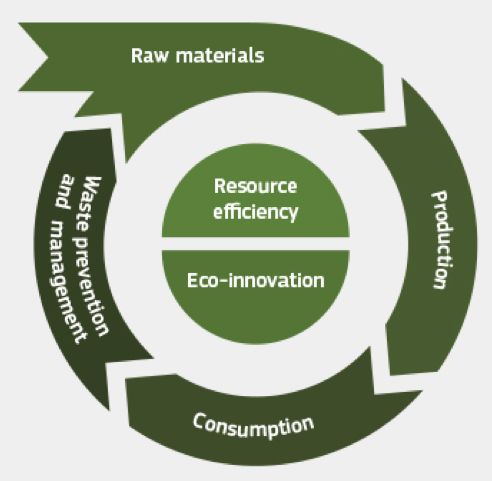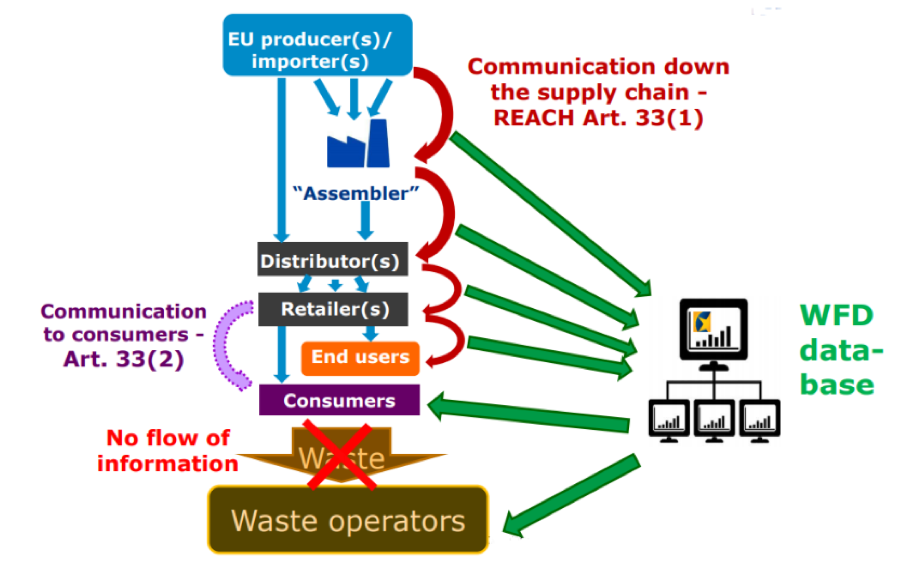Preparations for the EU Waste Framework Directive (WFD) database are gathering steam, especially with the European Chemicals Agency’s (ECHA’s) recently published “Detailed information requirements for the SCIP database.”
Under Article 9 of the WFD, ECHA is required to have the SCIP database in place by 5 January 2020 and ready for data submission beginning 5 January 2021. This will be a major undertaking for many industries but it will in theory be beneficial to the EU economy overall.
Read on to learn what role maintaining a database of the substances of concern in articles or in complex objects (products) (SCIP) will play in supporting a circular economy the EU is working toward.
The Problem of Hazardous Materials in the Circular Economy
As the global population continues to rise, our traditional linear model of consumption (take-make-use-dispose) is increasingly seen as unsustainable. Our world’s growing middle class paired with the corresponding growth of consumption is placing expanding pressure on the world’s finite resources.
The circular economy seeks to meet this problem with a more sustainable model of consumption. Using a model of manufacture-consume-recycle-reuse, previously-used resources would be continually cycled back into the manufacturing process rather than falling to waste.
But hazardous substances in secondary materials are a key barrier to realising a circular economy. How do recyclers know the hazardous substances of a product being recycled in order to handle and reprocess the product safely? How do recyclers avoid incorporating hazardous substances into recycled secondary materials?
The Importance of Transparency Regarding Hazardous Materials
To increase our ability to create a sustainable circular economy, we must take a multi-pronged approach in dealing with hazardous materials that can pose a threat to the reuse of recyclable materials. In order to safely deal with hazardous materials, recyclers should be provided with greater transparency about which materials contain hazardous substances. This will allow them to protect the safety of their workers and prevent contaminating recyclable materials with hazardous substances. This is where the importance of accuracy and transparency of inputting substance information into the WFD database is evidenced.
Another part of the solution is to encourage manufacturers to stop using hazardous substances in their products in the first place. This can be achieved by legal measures – e.g., the End of Life Vehicles (ELV) heavy metals restrictions on lead, mercury, cadmium and hexavalent chromium in vehicles), but it can also be encouraged through consumer pressure. By giving consumers information on the hazardous substance content of products, they can make informed decisions and stimulate the market to provide products with lower hazardous substance content. This, in turn, would reduce the hazardous substance content of products when these products eventually become waste.

https://ec.europa.eu/environment/green-growth/index_en.htm
Where the WFD Database Fits Into This
Under Registration, Evaluation and Authorization of Chemicals (REACH), there are already requirements for producers and importers of articles to inform ECHA about a Substance of Very High Concern (SVHC). But the WFD database will theoretically help address the current lack of transparency regarding hazardous substances for both ECHA and the general EU population.
For instance, under REACH’s Article 7(2) Notification, producers or importers of articles are required to notify ECHA when the articles they are placing on the market contain more than 0.1% SVHC and the tonnage being placed on the market exceeds more than one tonne per annum. But this does not apply if the substance is already registered for the same use it is being put on the market for; nor if exposure can be excluded. As a result, ECHA has received very few notifications and their information about where SVHCs are being used in products is limited.
Under Article 33(1) of REACH, any SVHC content in an article above 0.1% must be communicated to the next recipient in the supply chain in order to handle it safely. Additionally, Article 33(2) provides consumers with the right to request information on the SVHC of a product, together with safe use information.
But this places the onus on the consumer to make the request, which will more often than not act as a barrier for the consumer to obtain the SVHC content information.
But while Article 7(2) and Article 33 require information about hazardous material content to be provided to ECHA and consumers, it does not require the same information to be given to waste operators. This becomes a problem when a product with hazardous materials reaches the end of its life cycle.
To address this problem, ECHA anticipates using the WFD database to create an article-centric approach that can be accessed by consumers at the purchasing stage and accessed by waste operators after. All articles that are within the scope of Article 33 (those that contain SVHCs above 0.1%) would be reported into the system at the lowest tiers of the supply chain by EU manufacturers or importers. As those articles are assembled into more complex configurations and ultimately products, the database would be updated accordingly by the obligated party.
The figure below from the Workshop on Waste Framework Directive database-Proceedings illustrates how ECHA envisions the database being used.

Ultimately, this would allow waste operators access to the database and provide them with the ability to identify articles containing hazardous materials. As a result, they will better be able to protect their workers’ health and avoid contaminating recyclable materials with hazardous substances.
Consumers would also have access to the database, allowing them automatic access to information regarding hazardous substances instead of having to specially request it. This will allow them to make informed purchasing decisions, which will, in turn, encourage manufacturers and their suppliers to veer away from using hazardous substances in their products. ECHA will also be able to use the collated data to inform future decisions on regulating substances. So, what’s in store for your manufacturing operation?
Required WFD Database Inputs
EU manufacturers and importers will be required to report articles as such (e.g. an O Ring) or as part of complex objects (e.g. a car engine) that contain REACH SVHCs. The recently published detailed information requirements for the SCIP outlines both the mandatory and optional data that is to be input for articles and complex articles.
See the chart below for the mandatory fields of the SCIP.
| Article name | Main name assigned to the article as such or the complex object; free text |
| Primary Article Identifier | Numerical or alphanumerical identifier assigned to the article as such or the complex object and identification of its type. The primary Article Identifier will be used to support the preparation of a notification.
Type options: e.g. European Article Number (EAN); Global Trade Item Number (GTIN); Universal Product Code (GPC); Catalogue number; ECHA Article ID, part number. |
| Article category* | Identification of the article as such or the complex object from a harmonised list (with codes and description) which cannot be achieved by the article name(s) assigned, until a certain level of granularity, based on function/use. It is important to identify certain relevant waste streams.
Allowed values: The integrated Tariff of the European Union – TARIC – list, based on the Combined Nomenclature (CN) description and code [Annex I to Council Regulation (EEC) No 2658/87] (the relevant descriptions and codes must be selected). |
| Production in European Union | In this field, the duty holder answers to the question: is the article produced or assembled in the EU?
Allowed values: yes; no; unwilling to disclose |
| Safe use instruction(s)* | Safe use information. It includes the possibility to state that there is “No need to provide safe use information beyond the identification of the Candidate List substance”. |
| Linked article | Add a link to an existing article or create a new article or a complex object to link with this complex object. |
| Number of units | Number of occurrences of the linked article in the complex object |
| Candidate List version | Identification of the Candidate List substance version based on which the information on the article as such or complex object has been assessed against before being submitted to ECHA |
| Concentration range | Possible concentration ranges of the substance in the article:
> 0.1% w/w and < 0.3% w/w; ≥ 0.3% w/w and < 1.0% w/w; ≥ 1.0% w/w and < 10.0% w/w; ≥ 10.0% w/w and < 20.0% w/w; ≥ 20.0% w/w and < 100% w/w; > 0.1% w/w and ≤ 100% w/w. |
| Material category | Identification of the material the article (containing the Candidate List substance) is made of from a list to be provided by ECHA.
[It is important to identify certain relevant material-based waste streams. It also allows the identification of the article based on the material it is made of.] |
| Mixture category | Identification of the mixture category from the European product categorisation system (EuPCS) containing the Candidate List substance(s) incorporated in the further processing step (e.g. coating) of an article or incorporated when joining or assembling two or more articles in a complex object (e.g. adhesive, solder).
[It allows to identify where in the article the Candidate List substance is present.] |
For help preparing to input data for the Waste Framework Directive database as part of the circular economy, contact our REACH experts.







